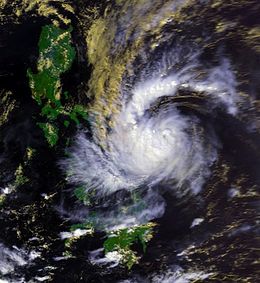Tropical Storm Thelma
| Tropical storm (JMA scale) | |
|---|---|
| Tropical storm (Saffir–Simpson scale) | |

Tropical Storm Thelma approaching the Philippines on November 4
|
|
| Formed | November 1, 1991 |
| Dissipated | November 8, 1991 |
| Highest winds |
10-minute sustained: 75 km/h (45 mph) 1-minute sustained: 85 km/h (50 mph) |
| Lowest pressure | 992 hPa (mbar); 29.29 inHg |
| Fatalities | 5,081 – 8,165 total |
| Damage | $27.67 million (1991 USD) |
| Areas affected | Philippines, Vietnam |
| Part of the 1991 Pacific typhoon season | |
| Deadliest Philippine typhoons | |||
|---|---|---|---|
|
|
|||
| Rank | Typhoon | Year | Deaths |
| 1 | September 1881 Typhoon | 1881 | 20,000 |
| 2 | Haiyan (Yolanda) | 2013 | 6,300 |
| 3 | Thelma (Uring) | 1991 | 5,100 |
| 4 | Bopha (Pablo) | 2012 | 1,901 |
| 5 | "Angela Typhoon" | 1867 | 1,800 |
| 6 | Winnie | 2004 | 1,619 |
| 7 | October 1897 Typhoon | 1897 | 1,500 |
| 8 | Ike (Nitang) | 1984 | 1,363 |
| 9 | Washi (Sendong) | 2011 | 1,268 |
| 10 | Trix | 1952 | 995 |
|
|
|||
|
|||
Tropical Storm Thelma, known in the Philippines as Tropical Storm Uring, was one of the deadliest tropical cyclones in Philippine history, killing at least 5,081 people. Forming out of a tropical disturbance on November 1, 1991, several hundred kilometers north-northeast of Palau, the depression that would become Thelma tracked generally westward. After turning southwestward in response to a cold front, the system intensified into a tropical storm on November 4 as it approached the Philippines. Hours before moving over the Visayas, Thelma attained its peak intensity with estimated ten-minute sustained winds of 75 km/h (45 mph) and a barometric pressure of 992 mbar (hPa; 29.29 inHg). Despite moving over land, the system weakened only slightly, emerging over the South China Sea on November 6 while retaining gale-force winds. Thelma ultimately succumbed to wind shear and degraded to a tropical depression. On November 8, the depression made landfall in Southern Vietnam before dissipating hours later.
While passing over the Philippines, Thelma's interaction with the high terrain of some of the islands resulted in torrential rainfall. Through a process known as orographic lift, much of the Visayas received 150 mm (6 in) of rain; however, on Leyte Island there was a localized downpour that brought totals to 580.5 mm (22.85 in). With the majority of this falling in a three-hour span, an unprecedented flash flood took place on the island. Much of the land had been deforestated or poorly cultivated and was unable to absorb most of the rain, creating a large runoff. This water overwhelmed the Anilao–Malbasag watershed and rushed downstream. Ormoc City, located past where the Anilao and Malbasag rivers converge, suffered the brunt of the flood. In just three hours, the city was devastated with thousands of homes damaged or destroyed. A total of 4,922 people were killed in the city alone, with 2,300 perishing along the riverbank.
...
Wikipedia
